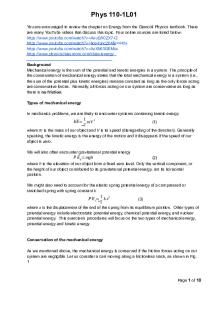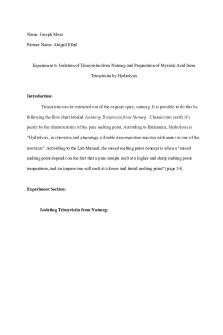Lab Report 5 Part 1 PDF

| Title | Lab Report 5 Part 1 |
|---|---|
| Author | Badal Poudel |
| Course | ENVIRONMENTAL ANALYSIS |
| Institution | The University of Texas at Arlington |
| Pages | 3 |
| File Size | 109.7 KB |
| File Type | |
| Total Downloads | 22 |
| Total Views | 137 |
Summary
Download Lab Report 5 Part 1 PDF
Description
CE 3131-002 Environmental Analysis Laboratory Fall - 2018
Laboratory Report 5
PART I Experiment : Ammonia - Nitrogen
Submitted by Group B Instructor : Dr. Srinivas Prabakar
Name of the group members: 1. 2. 3. 4 5.
Due Date: 10-24-2018 Date Submitted: 10-dd-2018
Background
Nitrogen cycle is a never-ending process on earth. Nitrogen is constantly being recycled by
living and dead organisms. Different form of nitrogen is found in a sample which gave the amount of pollution. Dead plants undergo decomposition and the organic nitrogen is released to the water as ammonia. If there are high levels of ammonia in water, it can help the growth of algal blooms. Algal blooms greatly decrease the amount of oxygen in the water which harm aquatic life and plants. Ammonia can cause odor and taste problem for water treatment plants. Additionally, it is very harmful to drink and could cause sickness and death. Treatment plants use a process to lower the amount of ammonia. They first determine the amount of ammonia by using the colorimeter in the process. The powder pillows are added first before going into the colorimeter. Once the colorimeter reads a good level of ammonia which is around 2 mg/L the water is safe.
Definitions and Significance Beer’s Law: The Beer-Lambert law states that the concentration of a chemical is directly proportional to the absorbance of a solution. This is significant because it helps in determining the concentration of chemical species in a given solution using a calorimeter. TKN:Total Kjeldahl Nitrogen or TKN is the total concentration of organic nitrogen and ammonia. It is a significant parameter for regulatory reporting at many plants and means of monitoring plant operations. Unit is mg/L. Organic Nitrogen: The term organic nitrogen is used to describe the nitrogen compound which is originated from a living material. For example, the nitrogen present in protein and urea is organic nitrogen. It is essential for the functioning of all living beings, helps mainly for muscle building, reproduction, and digestion. Unit is mg/L. Total Nitrogen: Total nitrogen is defined as the sum of TKN and nitrate-nitrite. It is an essential nutrient for plants and animals. But an excess amount of total nitrogen can cause high oxygen demand.Unit is mg/L. Citations: “Primer on Nitrogen”.,mbl ecosystems (Oct. 18, 2018) Clark, Jim. (2007) “ The Beer-Lambert Law ”., chemguide (Oct. 18, 2018) Materials and Methods For the ammonia-nitrogen experiment, each group tested a standard solution of ammonianitrogen and a diluted sample. 2.0 mL of prepared sample and 2.0 mL of deionized water were added to separate reagent vials. An ammonia salicylicate reagent powder pillow was emptied into the vial containing the standard solution and the vile was shaken for 5 seconds. Groups waited 10 seconds before emptying an ammonium cyanurate reagent powder pillow into the standard solution vile, and the vile was shaken for another 5 seconds. After 10 seconds, the same process was repeated for the vial containing the diluted sample. During the preparation of the vials, a DR 890 colorimeter was powered on and a blank vial was
inserted with a vial adapter. After the colorimeter displayed 0.00 mg/L NH3-N, each of the vials containing either the standard solution or the diluted sample were placed into the colorimeter. “Read” was pressed for each vial and the number was recorded. References ● Davis, M., and Masten, S., (2003). Principles of Environmental Engineering and Science, 3rd Ed., East Lansing, MI. ● “ Primer on Nitrogen ”., mbl ecosystems (Oct. 18, 2018) ● Clark, Jim. (2007) “ The Beer-Lambert Law ”., chemguide (Oct. 18, 2018) ● HARCH DR/890 colorimeter procedure manual Appendix Standard Group
mg/L AmmoniaNitrogen
A
2.11
B
2.15
C
2.06
Avera ge
2.11
Sample Group
mg/L Ammonia-Nitrogen
A
0.85
B
0.65
C
0.60
Average
0.70...
Similar Free PDFs

Lab Report 5 Part 1
- 3 Pages

Lab 7 Report Part 1
- 3 Pages

Lab report Biofuels Part 1
- 4 Pages

LAB 5 - Lab report
- 4 Pages

Lab Report 5 - lab
- 5 Pages

Lab 5 - Lab report
- 6 Pages

Calorimetry Part 2 Lab Report
- 6 Pages

Lab 5 - Lab experiment report
- 6 Pages

Lab Report 6 Part I
- 3 Pages

Lab 5 Lab Report- (Microbiology)
- 4 Pages

Company report part 1
- 11 Pages

Phys lab 5 - Lab report
- 10 Pages

Experiment 5 - Lab Report 5
- 16 Pages

Post Lab Report Lab 5
- 5 Pages

Lab 5 Report
- 5 Pages

Chem lab report 5
- 7 Pages
Popular Institutions
- Tinajero National High School - Annex
- Politeknik Caltex Riau
- Yokohama City University
- SGT University
- University of Al-Qadisiyah
- Divine Word College of Vigan
- Techniek College Rotterdam
- Universidade de Santiago
- Universiti Teknologi MARA Cawangan Johor Kampus Pasir Gudang
- Poltekkes Kemenkes Yogyakarta
- Baguio City National High School
- Colegio san marcos
- preparatoria uno
- Centro de Bachillerato Tecnológico Industrial y de Servicios No. 107
- Dalian Maritime University
- Quang Trung Secondary School
- Colegio Tecnológico en Informática
- Corporación Regional de Educación Superior
- Grupo CEDVA
- Dar Al Uloom University
- Centro de Estudios Preuniversitarios de la Universidad Nacional de Ingeniería
- 上智大学
- Aakash International School, Nuna Majara
- San Felipe Neri Catholic School
- Kang Chiao International School - New Taipei City
- Misamis Occidental National High School
- Institución Educativa Escuela Normal Juan Ladrilleros
- Kolehiyo ng Pantukan
- Batanes State College
- Instituto Continental
- Sekolah Menengah Kejuruan Kesehatan Kaltara (Tarakan)
- Colegio de La Inmaculada Concepcion - Cebu